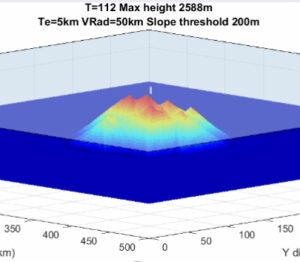This very simple numerical model helps us to understand what controls whether oceanic volcanoes reach sea-level to form islands. It shows how low-flexural rigidity oceanic lithosphere should respond to growth of an intraplate volcnic complex. Although the initial version of this model is as simple as possible, we can see how it could be analysed, and developed to explore the dynamic interaction between different volcanic, tectonic and erosion-deposition processes. The PowerPoint slides contain animations and some plots that show an analysis for each model of maximum volcano height. Volcanoes able to support steeper slopes are the key and thermal age, and therefore flexural rigidity of the underlying lithosphere, is less important control.

Modelling seafloor volcanoes (48.78 MB)
A simple numerical model that helps us to understand oceanic volcanoes reach sea-level to form volcanoes.


